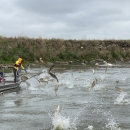The Risk Assessment Mapping Program (“RAMP”) is a mapping tool that uses the current geographic range of a species to predict the climate suitability of other geographic areas or future time periods. It was developed by the U.S. Fish and Wildlife Service (Service) primarily to assist with risk assessment of nonnative aquatic wildlife and plants.
Publication date
Type of document
Supporting Documentation
Media Usage Rights/License
Public Domain
Program



